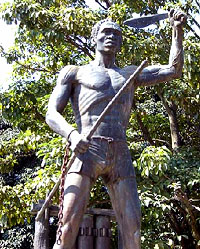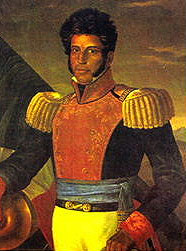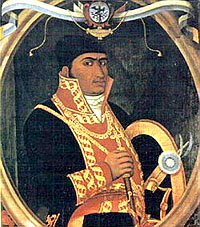|
Afro-Mexican Influence in Mexico
The history of the black race in Mexico is both
illuminating and mysterious. What makes the story of
especially profound is the
lack of documentation and discussion on the subject.
Scholars have long been acquainted with the history of
slavery in Mexico. In fact, long before the first
Spanish galleons appeared on the horizon, the practice
of slavery was common amongst several indigenous
tribes in Mexico. So while it may be said that the
Spanish did not invent slavery, they nonetheless
relied upon it to expand their empire and to increase
their already enormous wealth.
As the colonial period in Mexico unfolded, in
particular during the 16th and 17th centuries, the
indigenous population became decimated by disease. To
make up for this labor shortage, African slaves were
brought to Mexico to toil in sugar fields and work in
underground mines. Worth four times more than their
indigenous Indian counterparts, these African slaves
were highly prized for their reported physical
endurance and stamina in the hot, tropical sun.
 |
|
Gaspar Yanga | |
Made to work under horrendous conditions on the sugar
plantations of coastal Veracruz, attempting escape
from their captors was the only viable option for
these enslaved Africans. Those that were successful
fled to the area�s high mountain ranges where jungle
and canyons could hide and shelter them. Indigenous
Indians also fled to these remote areas and joined
forces with the escaped African slaves, forming
communities and families.
A famous rebellion in Mexico�s history was led by an
African slave named Gaspar Yanga, around the year
1570. Believed to be a member of the royal house of
Gabon, Africa, this hero was responsible for leading
his fellow black slaves in a successful revolt. Under
Yanga�s leadership, these slaves were able to escape
to safety in the highlands of Veracruz.
Remarkably, after 30 years of living in the mountains,
Yanga was able to negotiate a treaty with the Spanish.
This treaty was hard won and only obtained after great
hardship. However, in the end, Yanga achieved his
desired goal of his community remaining free. Today,
the town of Yanga in Veracruz is living testimony to
his incredible achievement.
 |
|
Vicente Guerrero | |
The mingling of blood that occurred between the
Spanish and Indigenous Indians of Mexico also took
place with African slaves. Historians differ on the
actual number of slaves brought to Mexico during the
colonial expansion. Some scholars believe 200,000
slaves were brought to Mexico for manual labor
purposes, while others believe the true number totaled
far more, upwards to 500,000.
Some of the blood of these enslaved blacks co-mingled
with that of the Indigenous Indians as well as the
Spanish. This �third root� of the Mestizo race is a
topic seldom acknowledged. Traditionally, the Mestizo
race is identified as being a mixture of European and
Indigenous Indian blood. In truth, it can also include
the blood of Africans. Over the years, this bloodline
has been absorbed into the fabric of the Mexican
population.
The first blacks to come to Mexico, as well as their
descendants, have greatly influenced Mexican culture.
Throughout the centuries, Afro-Mexicans have made
enormous contributions to the country and deserve
recognition for their many accomplishments.
Afro-Mexicans share a rich history and count heroes
and presidents amongst their ancestors.
Vicente Guerrero, a mulatto and Mexico�s 2nd
president, was a hero in Mexico�s War of Independence
from Spain. The state of Guerrero in Mexico was named
in his honor. His grandson, Vicente Riva Palacio y
Guerrero, was one of Mexico�s most influential
politicians and novelists. In addition, one of the
most prestigious generals in Mexican�s War of
Independence, Jos� Mar�a Teclo Morelos y Pav�n, was a
mulatto as well.
 |
|
Jose Maria Morelos y Pavon | |
Afro-Mexicans have also greatly contributed to
Mexico�s rich heritage of dance, music and song. The
famous carnival celebrated in Coyolillo in Veracruz
has African origins. Mexico�s food, language and
spiritual practices have been influenced by the
descendants of black slaves. Black immigrants to the
country must be recognized and included in this
equation as well. Many fled to Mexico during the years
of slavery in the United States, seeking asylum and
refuge.
Many Afro-Mexicans reside on Mexico�s Pacific Coast,
in an area known as the Costa Chica region. This
stretch of coastline starts just south of Acapulco and
extends for approximately 200 miles. Fishing and
agriculture are the mainstays of the economy in Costa
Chica. Afro-Mexican communities can also be found in
the states of Guerrero, Oaxaca, Michoac�n, Veracruz,
Campeche, Quintana Roo, and the Yucat�n.
|